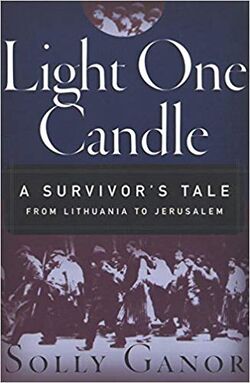Solly Ganor (M / Lithuania, 1928), Holocaust survivor
Solly Ganor (M / Lithuania, 1928), Holocaust survivor.
- KEYWORDS : <Kovno Ghetto> <Stutthof> <Dachau>
- MEMOIRS : Light One Candle (1995)
Biography
Book : Light One Candle (1995)
- Light One Candle: A Survivor's Tale from Lithuania to Jerusalem (1995)
"Forty-seven years after he was found half-dead in the snow, following a death march from Dachau, Solly Ganor again came face to face with his rescuer Clarence Matsumura at a reunion of Holocaust survivors and their American liberators. That meeting proved a catharsis, enabling Ganor to confront for the first time the catalogue of horrors he experienced during the Second World War. Beginning in prewar Lithuania, Light One Candle tells of the ominous changes that took place once Hitler came to power in 1933, of Chiune Sugihara, the Japanese consul who wrote thousands of exit visas for Jews fleeing the Nazi onslaught, of the brutal conditions in the Kaunas ghetto where Ganor spent most of the war, and of Stutthoff and Dachau, the concentration camps he was shuttled to and from in the last, desperate days of the war. Unflinching in its depiction of evil but uplifting in its story of the survival of the human spirit, Light One Candle is a gripping memoir that waited fifty years to be told."--Publisher description.
USHMM Oral Interview
Solly Ganor, born on May 18, 1928 in a small town of Heydekrug (Šilutė, Lithuania), describes his early life, the family's move to Kovno (Kaunas, Lithuania), and his encounter with the Japanese consul, Chiune Sugihara; his family’s attempt to flee Russia, but without success; returning to Kovno and ending up in a ghetto in Slobodka (Vilijampole), Lithuania; becoming involved with underground work; hiding books; working at the airport under harsh conditions; the relationship between the Judenrat and the chief rabbi; the Judenrat making of list of people to send to Riga, Latvia; the beginning of Jewish resistance in the ghetto; the relative quiet in the ghetto from 1942 to 1943; the ghetto orchestra; deportations to Estonia; his cousins joining Chaim Yellin’s partisans; the killings in the 9th Fort; his sister's release from the Nazis; a story about Joseph Kagan; being ordered to evacuate the ghetto in July 1944; being taken to Stutthof and later to an outer camp of Dachau, Camp 10 (Kaufering X in Utting am Ammersee, Germany); his father working in the concrete plant; witnessing the suicide of a Jew who pushed a cruel German into pouring concrete; lice in the camp; burying the dead; celebrating his father's birthday with a surprise party; being instructed to take inmates to Dachau in April 1945; evacuating from Dachau along with 8,000 other Jews on a death march; being liberated by Japanese American soldiers; translating for the American doctors who were treating survivors; being sent with his father to recuperate; going to Munich, Germany; working for the American army as a translator in the Counter Intelligence Corps (CIC); working for the United Nations Relief and Rehabilitation Administration. (UNNRA); leaving Germany and boarding a ship in Marseilles, France; arriving in Haifa, Israel in June 1948; and his first years in Israel.
